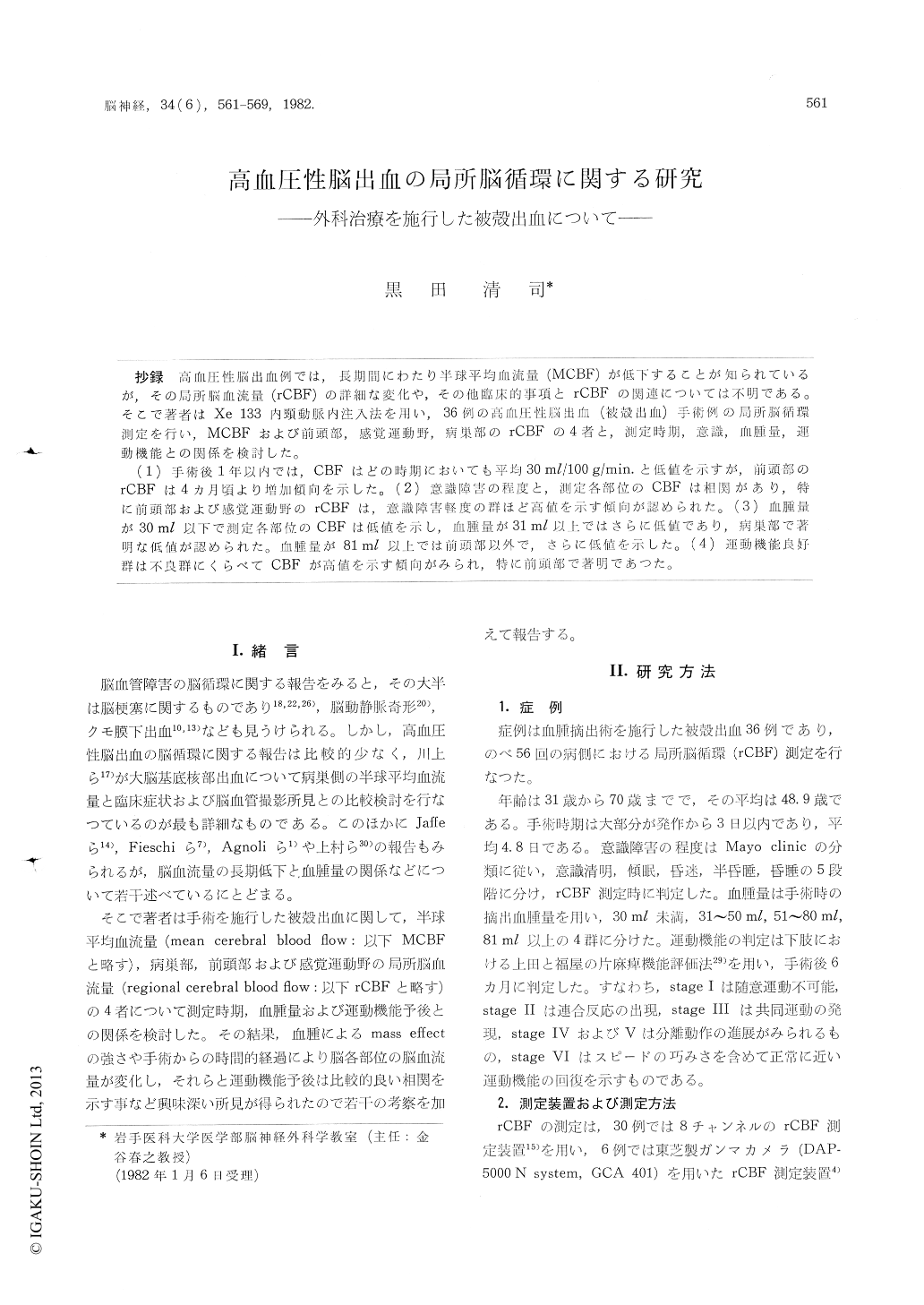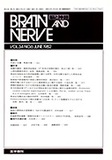Japanese
English
- 有料閲覧
- Abstract 文献概要
- 1ページ目 Look Inside
抄録 高血圧性脳出血例では,長期間にわたり半球平均血流量(MCBF)が低下することが知られているが,その局所脳血流量(rCBF)の詳細な変化や,その他臨床的事項とrCBFの関連については不明である。そこで著者はXe 133内頸動脈内注入法を用い,36例の高血圧性脳出血(被殻出血)手術例の局所脳循環測定を行い,MCBFおよび前頭部,感覚運動野,病巣部のrCBFの4者と,測定時期,意識,血腫量,運動機能との関係を検討した。
(1)手術後1年以内では,CBFはどの時期においても平均30ml/100g/min.と低値を示すが,前頭部のrCBFは4ヵ月頃より増加傾向を示した。(2)意識障害の程度と,測定各部位のCBFは相関があり,特に前頭部および感覚運動野のrCBFは,意識障害軽度の群ほど高値を示す傾向が認められた。(3)血腫量が30ml以下で測定各部位のCBFは低値を示し,血腫量が31ml以上ではさらに低値であり,病巣部で著明な低値が認められた。血重量が81ml以上では前頭部以外で,さらに低値を示した。(4)運動機能良好群は不良群にくらべてCBFが高値を示す傾向がみられ,特に前頭部で著明であつた。
Regional cerebral blood flow (rCBF) was measured in 36 patients with hypertensive intracerebral hemorrhage (putaminal hemorrhage) treated sur-gically, using the Xenon-133 intracarotid injection method. In a few previous studies, it has been reported that a long standing hemispheric cere-bral blood flow reduction was seen in such cases. However, the manner of rCBF changes and details of the duration of the flow reduction are not yet clarified. In the present study the correlations bet-ween CBF in four regions, (the hemisphere, the frontal region, the sensori-motor area and the focal (pathologic) area) and the duration from the opera-tion, the conscious level, the hematoma volume and motor function were investigated. The results obtained were as follows;
1) MCBF, rCBF in sensori-motor area and in the focal area showed a value below 30 ml/100 g/min. for any duration after the operation within one year. However, in the frontal region rCBF tends to increase from 4 months after the operation. In two cases which were measured for more than one year, MCBF and rCBF showed a higher value in all regions than that of the cases within one year.
2) There was a close correlation between the conscious level and CBF, especially in the frontal region. The higher CBF was noted in the better consciousness group.
3) In hematoma cases the larger the hematoma volume (especially those over 31 ml) the lower the CBF in all three regions. In the focal area rCBF showed the lowest value among these three regions and was dependent on the hematoma volume, while frontal region revealed the highest flow value of them all, even in cases with a hematoma volume over 81 ml.
4) There was a significant difference in rCBF between cases with severe motor disturbance and cases with moderate motor disturbance, except in the focal area. In the frontal region rCBF coincides rather well to the degree of motor disturbance ; i. e. cases with hyperfrontal rCBF pattern showed a moderate motor disturbance. While, rCBF in the focal area was less than 30 m7/100 g/min., and showed no correlation to motor function.
It might be concluded from these results that rCBF measurement is helpful to estimate the effects of mass lesion to brain function. Also, in cases with putaminal hemorrhage the disclosure of rCBF changes may make it possible to estimate the extent of motor function.

Copyright © 1982, Igaku-Shoin Ltd. All rights reserved.


